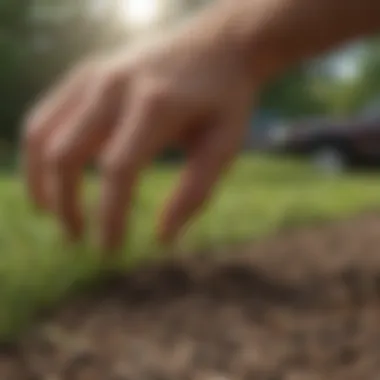Revitalize Your Patchy Lawn This Spring


Intro
Spring heralds a season of renewal, but for many homeowners and gardeners, it often brings the frustrating issue of patchy lawns. The uneven growth can stem from various factors, including soil quality, weather conditions, and pest infestations. Understanding these root causes is essential for effective lawn restoration. This article aims to provide a detailed examination of techniques needed to assess and improve the condition of a patchy lawn, focusing on strategies such as appropriate seeding methods, fertilization practices, and pest control management. Whether you are a lawn care professional, an avid gardener, or a homeowner facing this common problem, the insights gathered here will equip you with the knowledge necessary to achieve a uniform and vibrant lawn as the temperatures rise.
Latest Trends in Agriculture
Overview of Current Trends
Agriculture is rapidly evolving, and this includes its application to lawn care. Modern techniques that prioritize efficiency and sustainability are becoming prevalent. For example, there is a growing emphasis on soil health because it greatly impacts grass growth and vitality. Keeping soil rich in nutrients helps overcome issues like patchiness, as healthy soil can support robust plant life.
Impact of Technology on Farming Practices
Technological advancements play a crucial role in shaping contemporary gardening and lawn care methods. Soil testing technologies and precision agriculture tools allow for better understanding of nutrient needs. Drones can monitor lawn conditions from above, providing valuable data on areas that require attention. These technologies help in making informed decisions that can lead to better lawn outcomes.
Sustainable Practices: Towards a Greener Future
Importance of Sustainability in Agriculture
As the effects of climate change become more evident, there is an increasing need for sustainable agriculture practices. For lawns, this means adopting techniques that minimize the use of harsh chemicals and reduce water consumption. Sustainability in lawn care is beneficial for the environment and promotes long-term lawn health.
Methods for Sustainable Farming
- Organic Fertilizers: Using compost or natural fertilizers can improve soil quality without harming local ecosystems.
- Efficient Watering Techniques: Employing drip irrigation or rainwater harvesting can reduce water usage.
- Cover Cropping: Planting cover crops during off-seasons can prevent soil erosion and maintain nutrient levels.
By embracing sustainable practices, homeowners not only improve their lawn's resilience but also contribute to a healthier environment.
Gardening Techniques and Tips
Essential Gardening Tools and Equipment
A well-equipped gardener can successfully tackle the challenges of patchy lawns. Some essential tools include:
- Lawn mower for even cutting
- Rake for thatch removal
- Aerator for improving soil aeration
- Seed spreader for even distribution of grass seeds
These tools play a significant role in the maintenance and restoration of lawn quality.
Seasonal Gardening Practices
Understanding seasonal practices is vital. Spring is the ideal time for lawn care. Some important practices include:
- Assessment: Evaluate the soil condition and identify patchy areas.
- Seeding: Use high-quality grass seed suitable to the local climate.
- Fertilization: Apply the right type and amount of fertilizer to promote growth.
- Pest Management: Regularly inspect the lawn for pests that could damage grass.
By adhering to these practices, gardeners can effectively address patchy lawns as spring unfolds.
Understanding a Patchy Lawn
Understanding a patchy lawn is crucial for achieving a healthy and aesthetically pleasing landscape. Lawns that exhibit patchiness not only affect the overall look of a property but can also indicate deeper soil and growth issues that may require attention. This article will provide insight into the definition, characteristics, and common causes of patchiness, which are essential for any lawn care practitioner, gardener, or homeowner. By grasping these fundamental elements, readers can make informed decisions to tackle lawn problems effectively, leading to improved results during the spring season.
Definition and Characteristics
A patchy lawn refers to areas of grass that show irregular growth or dead spots, resulting in an uneven appearance. Common characteristics of patchy lawns include discolored patches, thin growth, bare spots, and increased susceptibility to weeds and pests. Identifying these traits is the first step in addressing the issues at hand. Special attention should be paid to how these patches interact with surrounding areas, as the compatibility of different grass species can affect overall lawn health.
Common Causes of Patchiness
Several factors contribute to the appearance of a patchy lawn. Understanding these causes is key to developing effective solutions. Below are some of the most common reasons for patchiness:
Insufficient Watering
Insufficient watering is a major factor contributing to patchiness. When grass does not receive enough moisture, it struggles to grow and thrive. This may manifest in areas that are consistently dry and weak. Consistent watering aims to activate the soil's processes and support healthy growth. A consistent, well-planned watering schedule is critical for overall lawn health, allowing the grass to develop strong roots and maintain proper hydration levels.
Soil Compaction
Soil compaction occurs when soil particles are compressed, reducing the pore space necessary for air and water movement. This condition prevents roots from growing deeply and accessing nutrients. Areas of high foot traffic or heavy machinery can exacerbate soil compaction. The primary concern is that compacted soil leads to less oxygen for the grass roots, resulting in stunted growth and patchiness. Addressing compaction through aeration can be an effective method to revitalize a lawn that suffers from this issue.
Poor Soil Quality
Poor soil quality plays a significant role in lawn health. Soils lacking essential nutrients or having imbalanced pH levels negatively impact grass growth. Compacted, sandy, or clay-heavy soils typically yield lower fertility. Since healthy lawns depend on nutrient-rich soil, it's essential to assess soil quality regularly. Enhancing soil health may involve applications of organic matter or fertilizers, which can significantly affect growth patterns in a patchy lawn.
Improper Mowing Practices
Improper mowing practices can lead to uneven grass growth as well. Cutting grass too short or infrequently can stress plants and harm their health. This stress can create an environment where patchy areas thrive due to dormant grass. Mowing at the correct height and frequency supports healthy growth. It's advisable to adjust the mowing schedule based on growth rates and seasonal changes to maintain balanced thickness and vigor across the lawn.
Pest Infestations
Pest infestations can lead to a decline in grass quality and appearance. Common pests such as grubs or chinch bugs feed on the roots or blades of grass. This feeding weakens the plants, making them more vulnerable to environmental factors and diseases. Regular monitoring for these pests and identifying early signs of infestation are crucial for prevention and treatment. Maintaining an awareness of local pest populations can aid in strategizing appropriate responses.
Climate Variability
Climate variability introduces unpredictable elements that impact lawn health. Temperature swings, irregular rain patterns, or prolonged drought can affect growth patterns significantly. Grass species may perform differently based on regional climatic conditions. Understanding the local climate and selecting appropriate grass types that can withstand these changes are vital. Additionally, maintaining a consistent care routine can help mitigate the impacts of these natural variances.
Pre-Season Preparation


Pre-season preparation is crucial when it comes to dealing with a patchy lawn in spring. The success of lawn restoration hinges on this early stage. By understanding the lawn's health before active growth starts, you can make informed decisions that affect its overall vigor. Taking the time to assess existing conditions allows one to effectively target specific issues, improving the chances of a flourishing lawn.
Assessing Lawn Conditions
Assessing lawn conditions comprises several methods to establish a clear picture of existing issues. It helps in pinpointing exact causes of patchiness, enabling targeted remedies.
Visual Inspection
A visual inspection serves as an initial diagnostic tool. It involves walking through the lawn, noting areas with irregular growth. Key characteristics include the appearance of yellowing grass, bare patches, and clumps of weeds. This method is beneficial because it offers a quick overview of the lawn's state without requiring specialized tools. A unique feature of visual inspection is its simplicity; it can be conducted by anyone at any time. However, its disadvantage lies in its subjective nature. Sometimes, it may overlook deeper soil issues that are not visible on the surface.
Soil Testing
Soil testing is more systematic and provides concrete data about the soil's condition. This process measures pH, nutrient levels, and organic matter content. The key characteristic of soil testing is its accuracy, making it a popular choice for understanding complex soil health. Soil testing's most significant advantage is its ability to reveal underlying problems that could affect grass growth, such as lack of nitrogen or high acidity. On the flip side, the need for lab evaluation can delay immediate action, which may not suit everyone’s timeline.
Thatch Evaluation
Thatch evaluation assesses the layer of organic material that accumulates on the soil surface. Key characteristics of thatch include its thickness, which should not exceed half an inch for optimal lawn health. This evaluation is beneficial, as it highlights areas where excessive thatch can impede water and nutrient absorption. A unique aspect of thatch evaluation is that it encourages appropriate management practices, such as aeration or dethatching. However, this approach also requires additional effort, such as digging small test patches, making it more labor-intensive than other assessment methods.
Planning for Spring Recovery
After assessing lawn conditions, planning for spring recovery becomes the logical next step. Setting clear goals and selecting the right turf varieties can make a significant impact on restoration efforts.
Setting Goals for Lawn Restoration
Setting goals for lawn restoration gives a focused direction for efforts. A key characteristic of goal-setting is that it allows for measurable outcomes, whether that be improved density or greener color. This approach is beneficial because it builds a roadmap for the restoration process, allowing property owners to track their progress. Its unique feature is the capacity to prioritize specific areas and issues based on assessment outcomes. The downside, however, is that overly ambitious goals can lead to frustration if not achieved in a timely manner.
Selecting Appropriate Turf Varieties
Selecting appropriate turf varieties is fundamental to ensure that the grass thrives in local conditions. This aspect involves considering sun, shade, and soil type to make informed choices. The key characteristic here is adaptability; choosing the right variety for specific environments contributes to overall lawn resilience. This method is beneficial, as it recognizes the diversity of grass types and encourages informed decisions. A unique feature of this selection process is the potential for long-term sustainability. However, a disadvantage may arise from the myriad options available, as selection can be overwhelming without proper guidance.
"Effective pre-season preparation lays the groundwork for a successful lawn recovery throughout the spring."
By investing time into preparation, the pathway to a lush and healthy lawn becomes clearer.
Soil Management Techniques
Soil management techniques are critical for the success of any lawn restoration effort. Poor soil conditions can hinder grass growth and lead to the issues seen in patchy lawns. This section will cover strategies focused on improving soil quality through organic matter addition, pH adjustment, and maintaining nutrient balance. Each of these techniques offers specific benefits that can ultimately facilitate a healthier lawn.
Improving Soil Quality
Organic Matter Addition
Adding organic matter is important for enhancing soil quality. It improves soil structure, water retention, and microbial activity. Organic matter, such as compost, not only provides nutrients but also encourages earthworm activity which benefits soil aeration. Its key characteristic is that it enhances the biological health of the soil. This practice eases compaction and fosters a thriving lawn ecosystem.
The unique feature of organic matter addition is its long-term benefits. Organic matter gradually decomposes, enriching the soil over time. One disadvantage is the initial cost and labor involved in applying sufficient organic materials.
pH Adjustment
pH adjustment is another essential soil management technique. Soil pH directly affects nutrient availability for plants. A balanced pH level, typically around 6 to 7, is optimal for most turf grasses. The key characteristic of pH adjustment is its immediate impact on soil chemistry, ensuring nutrients are accessible to grass roots.
Lime or sulfur can be used for adjusting pH levels. Lime raises the pH, making soil less acidic, while sulfur decreases the pH. A unique feature of pH adjustment is the specificity it offers to different turf species, making it crucial for tailored lawn care. However, improper adjustments can lead to nutrient lockout or harm turf, indicating caution is necessary in practice.
Nutrient Balance
Maintaining a nutrient balance is vital for optimal lawn health. Key nutrients such as nitrogen, phosphorus, and potassium must be present in adequate amounts for grass to grow vigorously. A nutrient imbalance can lead to either deficiencies or toxicities, both of which can worsen a patchy lawn.
Nutrient balance can be maintained through regular soil testing and targeted fertilization strategies. This practice is beneficial because it adjusts nutrient application based on specific soil needs. The unique feature is that it allows for a more scientific, data-driven approach to lawn care. However, reliance on fertilizers may sometimes lead to over application, which could harm beneficial soil organisms and lead to environmental concerns.
Aeration Practices
Core Aeration
Core aeration is an effective technique for improving soil aeration and reducing compaction in lawns. It involves removing small plugs of soil to promote better root growth and water infiltration. The key characteristic is its physical disruption of compacted soil layers, providing room for grass roots to expand.
Core aeration has a notable advantage. It enhances water absorption and allows nutrients to penetrate deeper into the soil. However, it requires specific equipment or rental tools, which may involve some additional cost.
Slicing and Spiking
Slicing and spiking are alternative aeration methods that help improve soil structure. Slicing involves making shallow cuts in the soil, while spiking drives solid tines into the ground. Both techniques improve surface drainage and promote root development.
The key characteristic of slicing and spiking is that they can be performed more quickly than core aeration. They can also be beneficial if the soil is too hard for traditional aeration methods. However, the downside is that these methods may not address deep compaction effectively.
Timing and Frequency
The timing and frequency of aeration practices significantly influence their effectiveness. The best time to aerate is during peak growth periods of the lawn, generally in spring or early fall. Regular aeration every one to three years is recommended for regular lawn maintenance.
The key characteristic of this approach is its adaptability to different grass species and local climate conditions. This tailored approach helps in maximizing benefits. However, improper timing, such as aerating during a drought or extreme heat, can cause stress to the lawn and lead to additional complications.
Seed Selection and Application
Seed selection and application are critical components in addressing the issue of a patchy lawn in spring. The right choice of seed can significantly influence the recovery process, as it determines how well the lawn adapts to its environment. Furthermore, effective application techniques can enhance seed germination and establishment, laying the foundation for a uniform and healthy lawn. This section will detail how to select suitable seeds, assess their quality, and apply them correctly to achieve the best results.
Choosing the Right Seed


Choosing the right seed involves understanding the specific conditions of your lawn, including climate, soil type, and existing grass species. It is important to select varieties that are well-adapted to local environmental conditions. For example, Cool-season grasses like Kentucky bluegrass thrive in northern climates, while Warm-season grasses such as Bermuda grass do better in the south.
Species Considerations
Species considerations are crucial in determining which grass type will flourish in your lawn. Different species come with unique characteristics. For instance, Fescue grasses are known for their drought resistance and adaptability to various soil types. This makes them a popular choice for lawns subjected to variable weather. However, their susceptibility to disease can be a drawback in humid areas. The choice of species impacts not just aesthetic outcomes but also the lawn's resilience and maintenance needs.
Seed Quality Assessment
Seed quality assessment includes examining germination rates, purity, and the presence of weed seeds. High-quality seeds usually have a higher germination rate, meaning more seeds sprout and establish in the soil. This leads to quicker recovery of the lawn after patchiness. A seed labeled with a high purity percentage contains fewer weed seeds, reducing competition for nutrients and space once sown. While good quality seeds may require a greater initial investment, the long-term benefits often outweigh the costs.
Seeding Techniques
Seeding techniques are equally vital in restoring a patchy lawn. The method of application directly affects how well the new seeds integrate with the existing grass.
Overseeding vs. New Seeding
Overseeding involves spreading new seed over existing grass, which can rejuvenate an aging or thin lawn. This method allows you to improve the density without disturbing the current root system. It’s a beneficial option because it tends to be less labor-intensive and can provide immediate aesthetic improvement. In contrast, new seeding requires soil preparation and is used typically for completely bare areas. The downside is that it takes longer for the lawn to establish.
Seeding Rates and Depth
Seeding rates and depth are the next important factors to consider. Each grass species has recommended seeding rates that maximize growth potential without overcrowding. Generally, the seeds should be sown at a depth of about 1/8 to 1/4 inch. Planting too deep can hinder their ability to germinate, while too shallow can expose them to drying out. Adhering to these guidelines helps in achieving a healthy, robust lawn.
Timing of Seeding
Timing of seeding is critical in ensuring optimal growth conditions. Early spring is often viewed as an ideal time to seed cool-season grasses as temperatures are favorable for germination. If you plan to sow warm-season grasses, late spring is preferable. The unique feature of timing is understanding the local climate fluctuations, which might necessitate adjustments. It is vital to monitor soil temperature and conditions to ensure successful seed germination.
"Choosing the right seed and timing the application can significantly enhance lawn recovery and uniformity."
By understanding seed selection and application, lawn enthusiasts can take informed steps towards restoring patchy areas effectively, ensuring a thriving green space as the season progresses.
Nutrient Management
Understanding nutrient management is central to the health of any lawn, especially during the spring when growth is resuming. Nutrient management encompasses the processes and practices that ensure your lawn receives the necessary nutrients for optimal growth. A well-nourished lawn is more resilient, requires less water, and can recover from adverse conditions more effectively. The benefits of proper nutrient management extend beyond aesthetics, impacting the lawn’s overall health, root development, and resistance to pests and diseases.
Fertilization Strategies
Fertilization strategies are essential components of nutrient management. The timing, type, and application method of fertilizers can significantly influence the success of lawn restoration efforts. A well-planned fertilization approach contributes to improved grass color, density, and stress tolerance. Specifically, applying fertilizers at the proper growth stages—typically in early spring—can promote vigorous growth and establish a stronger lawn. Additionally, it's vital to consider soil types and existing nutrient levels when developing a fertilization plan.
Nitrogen Sources and Timing
Organic vs. Synthetic Fertilizers
Organic and synthetic fertilizers each serve distinct purposes in nutrient management. Organic fertilizers, such as compost or manure, improve soil structure and increase biodiversity in the soil ecosystem. They release nutrients slowly, providing a more sustainable source of nourishment to plants. Conversely, synthetic fertilizers deliver nutrients quickly, which can lead to rapid growth. However, they may not enhance soil health over time. The choice depends on the specific lawn's needs and long-term goals. Organic fertilizers are often favored for their reduced environmental impact and lasting benefits to soil fertility.
Application Rate Guidelines
Application rate guidelines dictate the amount of fertilizer needed for effective nutrient delivery. Proper rates are essential to prevent over-fertilization, which can lead to nutrient runoff and environmental issues. Most recommendations suggest applying between one and two pounds of nitrogen per 1,000 square feet per season. Strict adherence to these guidelines ensures that your lawn receives adequate nutrients without the risk of harming the ecosystem. Unique to this aspect is the need for calibration based on lawn conditions and previous fertilization history.
Key Takeaway: Proper nutrient management is critical for lawn health, influencing growth, resilience, and overall appearance.
Watering and Irrigation Practices
Establishing Proper Watering Regimen
Frequency of Watering
The frequency of watering plays a significant role in establishing a healthy lawn. Generally, lawns benefit from deep, infrequent watering rather than shallow, frequent sessions. This technique encourages deeper root growth, making grass more resilient during dry spells.
A beneficial choice for most lawns is to water once or twice a week. The unique feature of this approach is that it allows the soil to dry out between watering sessions, preventing fungal diseases and promoting healthy root structures. However, over-watering can lead to issues such as water runoff or shallow roots, which might disadvantage the lawn's long-term health.
Amount of Water Per Session
The amount of water to apply per session is another critical aspect to consider. It is generally recommended to apply about one inch of water per week. This ensures that the grass gets sufficient moisture while encouraging deep root growth.
One key characteristic of this practice is its balance. Too little water can create stress for the lawn, while too much can lead to saturation and potentially drown the grass. The unique feature of this method is that it can be adjusted based on rainfall. For lawn care, knowing how much water to apply will significantly impact the overall effectiveness of your lawn care regimen.
Irrigation Systems Overview
Employing the right irrigation systems can simplify the process of maintaining optimal moisture levels in your lawn. Various types of irrigation systems are suitable for different lawn sizes and shapes. Understanding these systems is crucial for effective lawn management.
Types of Irrigation Systems
Each type of irrigation system has its distinct advantages and disadvantages. For instance,
- Sprinkler Systems: These are versatile and can cover large areas. They can be stationary or rotating, ensuring an even distribution of water. However, they may lead to overspray and runoff on sloped areas.
- Drip Irrigation: This system directs water exactly where it’s needed, minimizing waste. It is less labor-intensive but may require more setup and maintenance.
- Soaker Hoses: These hoses release water along their length and are excellent for garden beds but less effective for larger lawns.
Selecting the right system depends on your lawn's unique needs and characteristics.
Automation and Scheduling
Automation and scheduling in irrigation allow for efficient water management without constant supervision. Automated systems can adjust watering times based on weather conditions, which can prevent over-watering during rainy periods and ensure adequate moisture during dry spells.
A notable feature of automation is the ability to program the system to water at specific times of the day. This promotes better absorption and minimizes evaporation losses. However, the downside could be the initial cost of installation and the need for routine maintenance to ensure functionality.


"Establishing a proper watering regimen and selecting the right irrigation system can make a significant difference in maintaining a healthy lawn."
Understanding and implementing effective watering and irrigation practices is essential for any homeowner or gardener aiming to combat patchiness in their lawn during spring. By carefully managing water frequency and amount, and investing in suitable irrigation systems, the likelihood of achieving a lush and healthy lawn increases significantly.
Pest and Disease Management
Pest and disease management plays a crucial role in maintaining a healthy lawn. Understanding this area not only helps to prevent further damage but also allows for a proactive approach to lawn care. Effective pest and disease strategies can enhance the overall appearance of the lawn and contribute to its long-term vitality. Without addressing these challenges, the efforts put into improving a patchy lawn can be nullified, leading to ongoing issues.
Identifying Lawn Pests
Insect Deficiencies
Insect deficiencies occur when beneficial insects, which usually help in controlling harmful pests, are lacking. This can lead to an unregulated growth of unwanted insects that can damage the lawn. The absence of these natural predators might worsen the condition of a patchy lawn. Awareness of insect deficiencies is vital, as it highlights the importance of biodiversity in maintaining a healthy lawn ecosystem. While it is common to discuss harmful pests, recognizing that beneficial species are in decline helps in developing a more balanced ecosystem. One disadvantage may be the increased pest presence that arises when beneficial insects are scarce.
Common Lawn Diseases
Common lawn diseases, such as brown patch or dollar spot, significantly contribute to patchiness in a lawn. These diseases often flourish in specific conditions, such as high humidity or improper mowing, which makes their identification critical. Recognizing the signs of these diseases early can prevent extensive damage and help maintain a uniform lawn. The defining feature of common lawn diseases is their ability to spread rapidly under conducive conditions. While focusing on these diseases is essential, it is also necessary to consider the environmental factors that promote their growth. Failure to manage these diseases early can lead to severe damage and potentially require more radical restoration approaches.
Control and Prevention Methods
Integrated Pest Management
Integrated Pest Management (IPM) combines multiple strategies for managing pests effectively. This approach includes both biological and mechanical control methods, making it a sustainable choice for lawn care. The key characteristic of IPM is its focus on long-term prevention and minimal environmental impact. This makes it a popular choice for those seeking eco-friendly solutions for their lawns. One advantage of IPM is that it reduces pesticide reliance, which can lead to healthier surroundings. However, it requires a commitment of time and observation to be effective fully.
Chemical Treatment Considerations
Chemical treatments can provide immediate relief against pests and diseases in a lawn. These treatments are often necessary when dealing with severe infestations or diseases that threaten the lawn's integrity. The defining feature of chemical treatment is its swift action in targeting specific pests and pathogens. While these treatments can be beneficial, they also carry risks associated with their use, such as potential harm to beneficial insects and broader environmental implications. Understanding when and how to apply these treatments is essential to balance effectiveness with ecological safety.
"A well-informed approach to pest and disease management is one of the most effective ways to ensure a healthy lawn, particularly in spring."
Maintaining a proactive stance on pest and disease management not only fosters a vibrant lawn but also ensures that subsequent recovery efforts are more successful.
Ongoing Lawn Care Practices
Ongoing lawn care practices play a critical role in maintaining a healthy lawn throughout the spring season. Regular attention to various aspects of lawn maintenance not only addresses existing issues but also prevents future problems. Continued care helps in achieving dense, lush grass while managing the various factors that lead to patchiness. Key elements in these practices include regular maintenance routines and the monitoring of progress, both of which ensure the lawn thrives long after the initial restoration processes are in place.
Regular Maintenance Routines
Mowing Frequency
Mowing frequency directly impacts the overall health of your lawn. Regular mowing promotes denser growth and helps maintain an even height. Most homeowners should aim to mow their lawns once a week during the peak growing season. The specific aspect of this routine lies in how frequently you cut the grass. Cutting too infrequently can lead to uneven growth, while cutting too often can stress the grass. The key characteristic is finding a balance that encourages healthy turf without over-mowing.
Moreover, mowing allows light to reach the lower blades, facilitating photosynthesis and enhancing growth. A unique feature of regular mowing is that it prevents weeds from seeding by cutting them down before they have a chance to spread. One disadvantage, however, is that improper mowing practices, such as using dull blades, can cause ragged cuts that make the lawn more susceptible to disease.
Mulching Practices
Mulching practices significantly contribute to lawn care by returning nutrients back to the soil. When grass clippings are left on the lawn, they break down and provide essential nutrients, reducing the need for synthetic fertilizers. A key characteristic of mulching is its ability to retain moisture, which is especially valuable during dryer spells.
Choosing to mulch can be a beneficial practice as it reduces waste and promotes ecological balance in the lawn's ecosystem. A unique feature of mulching is its dual benefit as both a nutrient source and a natural weed suppressor. One downside is that leaving too many clippings can lead to a thick layer that suffocates the grass below if not managed well.
Monitoring Progress
Assessing Lawn Density
Assessing lawn density is a vital part of ensuring your lawn retains its health and vigor. This involves evaluating how thickly the grass covers the soil, which reflects its overall health. A dense lawn is typically considered a sign of successful care. The key characteristic of monitoring density focuses on recognizing both areas of lush growth and those that appear sparse.
A beneficial aspect of this practice is the potential for early detection of issues. Denser lawns can better withstand drought and are more resilient against pests. The unique feature of assessing density is that it provides insight into whether your efforts are yielding success or if further adjustments are needed. Disadvantages may arise when lawns are over-fertilized, leading to lush growth that can’t sustain the weight or is more prone to disease.
Adjusting Care Techniques
Adjusting care techniques is essential for adapting to the changing needs of your lawn, particularly as weather patterns shift in spring. This involves making necessary changes based on assessments of your lawn's performance. The key characteristic of this practice lies in its flexibility; the ability to pivot your approach based on real-time observations can make a significant difference.
For instance, if lawn density is low, you might increase watering or apply specific fertilizers to boost health. This adaptability is a popular choice in lawn care as it encourages continuous improvement. A unique feature of this approach is that it fosters a more personalized care routine. However, a disadvantage is that frequent changes to techniques can lead to stress in grass if not executed carefully.
Regular assessments and tailored adjustments ensure your lawn not only recovers from patchiness but thrives in resilience.
By implementing consistent routines and closely monitoring progress, homeowners can effectively combat the challenges of a patchy lawn. This ongoing dedication is vital in achieving a robust, healthy lawn over time.
The End and Future Considerations
The challenges of maintaining a lush lawn during spring cannot be overstated. Addressing patchiness effectively not only enhances the aesthetic appeal of one’s property but also significantly contributes to the overall health of the lawn. Understanding this topic is crucial for homeowners, gardeners, and lawn care professionals alike. A thorough grasp of the strategies discussed throughout this article—such as soil management, seeding techniques, and pest control—equips individuals with the necessary tools to tackle issues that arise during the critical spring season.
Moreover, recognizing the importance of continuous care leads to better long-term outcomes. Not all patchy lawns are salvageable with a single approach; ongoing attention is essential for sustained wellness. The benefits of meticulous lawn care are manifold, ranging from increased property value to improved environmental health.
Summary of Key Insights
Throughout this article, several key insights have emerged regarding the management of patchy lawns. Here are the primary takeaways:
- Assessment is Vital: Regularly evaluate lawn conditions through visual inspection and soil testing to identify problem areas.
- Soil Quality Matters: Implement soil management techniques to improve nutrient availability and promote healthy grass growth.
- Appropriate Seeding: Choose the right type of grass seed suitable for the climate and lawn conditions, ensuring proper application techniques.
- Ongoing Maintenance: Establish regular maintenance routines that include mowing, watering, and monitoring for pests and diseases.
Utilizing these insights effectively paves the way for a healthier, more resilient lawn.
Evolving Lawn Care Trends
The field of lawn care is continually evolving, driven by advancements in technology and a growing awareness of environmental sustainability. Some emerging trends include:
- Smart Irrigation Systems: These technologies automate watering based on real-time weather data, optimizing water usage and reducing waste.
- Organic Fertilizers: Many are shifting towards organic options, as these are less harmful to the environment and promote a healthier ecosystem.
- Drought-Resistant Grasses: As climate conditions change, selecting drought-resistant grass varieties has gained popularity, minimizing water consumption.
- Precision Lawn Care: Utilizing tools that allow for targeted treatment based on specific lawn needs is becoming more common, increasing efficiency in lawn management.
Staying informed about such trends is essential for adapting and evolving one's lawn care practices, ensuring a thriving green space for years to come.







